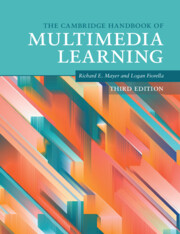Book contents
- The Cambridge Handbook of Multimedia Learning
- The Cambridge Handbook of Multimedia Learning
- Copyright page
- Contents
- Figures
- Tables
- Contributors
- Preface
- Acknowledgments
- Part I Background
- Part II Theoretical Foundations
- 5 Cognitive Theory of Multimedia Learning
- 6 Implications of Cognitive Load Theory for Multimedia Learning
- 7 Integrated Model of Text and Picture Comprehension
- 8 Implications of the Four Component Instructional Design Model for Multimedia Learning
- 9 Motivation and Affect in Multimedia Learning
- 10 Metacognition in Multimedia Learning
- Part III Basic Principles of Multimedia Learning
- Part IV Principles for Reducing Extraneous Processing in Multimedia Learning
- Part V Principles for Managing Essential Processing in Multimedia Learning
- Part VI Principles Based on Social and Affective Features of Multimedia Learning
- Part VII Principles Based on Generative Activity in Multimedia Learning
- Part VIII Multimedia Learning with Media
- Author Index
- Subject Index
- References
9 - Motivation and Affect in Multimedia Learning
from Part II - Theoretical Foundations
Published online by Cambridge University Press: 19 November 2021
- The Cambridge Handbook of Multimedia Learning
- The Cambridge Handbook of Multimedia Learning
- Copyright page
- Contents
- Figures
- Tables
- Contributors
- Preface
- Acknowledgments
- Part I Background
- Part II Theoretical Foundations
- 5 Cognitive Theory of Multimedia Learning
- 6 Implications of Cognitive Load Theory for Multimedia Learning
- 7 Integrated Model of Text and Picture Comprehension
- 8 Implications of the Four Component Instructional Design Model for Multimedia Learning
- 9 Motivation and Affect in Multimedia Learning
- 10 Metacognition in Multimedia Learning
- Part III Basic Principles of Multimedia Learning
- Part IV Principles for Reducing Extraneous Processing in Multimedia Learning
- Part V Principles for Managing Essential Processing in Multimedia Learning
- Part VI Principles Based on Social and Affective Features of Multimedia Learning
- Part VII Principles Based on Generative Activity in Multimedia Learning
- Part VIII Multimedia Learning with Media
- Author Index
- Subject Index
- References
Summary
This chapter summarizes research and theory concerned with the effect of learner motivation and emotional states on multimedia learning. It describes trends and issues in the current approaches, identifies relevant theoretical models, and assesses the importance of motivation (including interest, intrinsic-extrinsic motivation, goal orientation, and self-efficacy) and affect (including positive and negative affective states) as mediators and moderators of the effects of multimedia learning on cognitive outcomes. The reviewed empirical findings indicate the strong influence of multimedia learning environments on learner motivation and affect.
- Type
- Chapter
- Information
- The Cambridge Handbook of Multimedia Learning , pp. 121 - 131Publisher: Cambridge University PressPrint publication year: 2021
References
- 2
- Cited by



